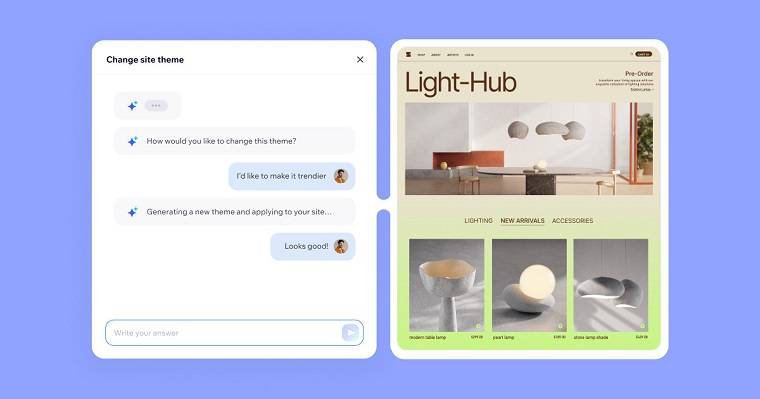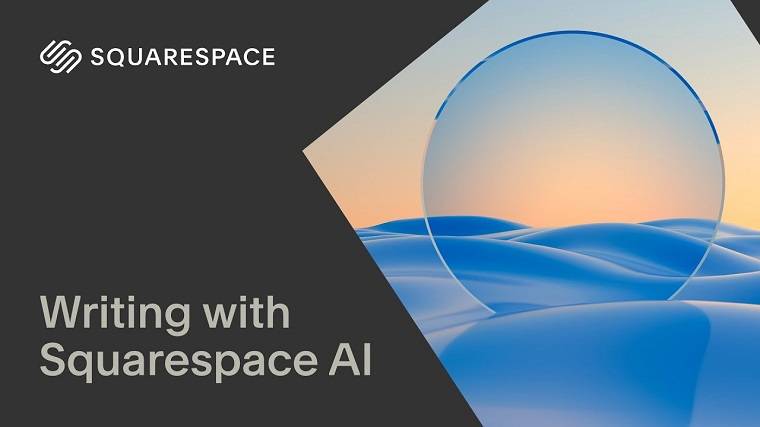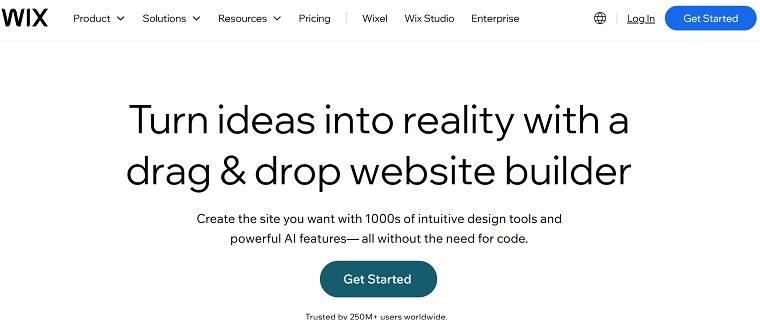In 2025, selecting a website platform goes beyond mere features; it’s about ensuring your digital presence remains resilient and adaptable for the future.
This guide compares Wix, Squarespace, and WordPress across five key areas—AI tools, design flexibility, SEO readiness, performance, and total cost—so you can make a decision that matches your business goals.
Platform Visions: Where Each Player is Headed
Wix: AI site+store creation with marketing tools, though limited customization
Integrated Marketing Tools: A Key Strength
Your e-commerce success starts with the platform’s powerful integrated marketing tools. Smart AI algorithms analyze your customers’ data to deliver personalized product recommendations—boosting average order value and building long-term loyalty. With seamless integration to Instagram, Facebook, and more, you can effortlessly sync your product catalog across channels, extend your reach, and drive more sales.
Surfacing Limitations in Ecommerce Functionality
However, with Wix AI Site Builder 2.0, you might run into some e-commerce challenges. If your store has complex operations, managing inventory—especially with product variations—can become a headache, leading to stock inconsistencies. And while the platform provides design templates, customization is limited, which can make it harder for you to create a truly unique brand experience and stand out from the competition.
Squarespace: Sleek design, All-in-one convenience, Strong brand appeal

Design-First Philosophy Meets Functionality Walls
Squarespace places a premium on design excellence via its visually captivating templates. However, its design-centric approach can limit functionality.
Customization for specific business needs may be difficult due to design constraints, and complex integrations often lack seamless execution.
The “All-In-One” Promise vs. Reality
Squarespace may present itself to you as an “all-in-one” solution for website building, hosting, e-commerce, and marketing. However, while it offers various tools, you might encounter limitations.
Its e-commerce features may lack certain payment options or efficient inventory management, and its marketing tools may not match dedicated platforms.
Emerging Competitors In Creative Spaces
Squarespace faces challenges from competitors such as Wix, Shopify.
You’ll find Wix offers user-friendly templates, while Shopify shines in e-commerce. These platforms match Squarespace in design but outperform it in functionality, customization, and cost, meaning you’ll see Squarespace needing to innovate to stay competitive.
WordPress: FSE Potential, Plugin Ecosystem Challenges, Enterprise Headless Solutions

WordPress Full Site Editing (FSE) maturity
In the WordPress ecosystem, you’ll find FSE aims to revolutionize website editing by removing traditional limitations. It’s made progress with its visual interface, but you may notice it still falls short in plugin compatibility and complex design support. As FSE-related development grows, it will need more tech innovation and community effort to reach full maturity, which could reshape WordPress’ market position for you.
The Plugin Bubble: What’s Sustainable?
WordPress’plugin ecosystem is vast, but you may encounter issues. The surge of similar-function plugins can lead to resource waste and confusion for you when choosing tools.
Plus, poor maintenance or compatibility issues may cause challenges for you in terms of plugin sustainability. To build a healthier ecosystem, you need stricter reviews, developer collaboration, and greater user awareness of these issues.
Headless WordPress for Enterprises
For your enterprise, Headless WordPress can be a critical digital-transformation tool. Unlike traditional WordPress, it separates the CMS from the front-end, letting you use custom front-end frameworks. This enhances content-publishing efficiency, integrates smoothly with your business systems, and stands out in security and scalability. Its rising use in large projects indicates a promising future in the enterprise market for your team.
A 2025 Analysis of AI Competitiveness Among the Top 3 Website Builders
AI is transforming web development, so choosing the right platform matters more than ever for your business. Here’s a quick 2025 comparison of the three leaders: Wix offers AI-powered simplicity, Squarespace provides designer-ready templates, and WordPress gives you limitless customization. Evaluate which option most effectively meets your needs.
AI Integration

- Wix: Features AI Site Builder 2.0 for automated layouts
- Squarespace offers AI-driven copywriting services and visual style matching capabilities.
- WordPress enables third-party AI integrations such as ChatGPT via its plugin ecosystem.

Design Flexibility

- With Wix, you can use a drag-and-drop editor that comes with fixed template structures.
- Squarespace: Industry-leading templates (CSS customization requires technical skills)
- WordPress: Full code control with block editor functionality

E-commerce Capabilities
- Wix: Comprehensive basic marketing tools (limited to 1,000 SKUs)
- Squarespace: Excellent visual product displays (limited payment gateway options)
- WordPress: WooCommerce allows unlimited expansion (with steeper learning curve)
Technical Architecture
- Wix: Closed SaaS system (no server access)
- Squarespace: Semi-open API (requires premium subscription)
- WordPress: Native support for headless CMS architecture
SEO Performance

- Wix: Automatic structured data generation (fixed URL structures)
- Squarespace features clean semantic code, though it offers limited Schema markup options.
- WordPress offers complete SEO control via plugins like RankMath and other professional tools.
Total Cost of Ownership
- Wix: 23−49/month (basic features included)
- Squarespace: 36−65/month (premium e-commerce features extra)
- WordPress: 4hosting+100/year for plugins (plus maintenance costs)
 |
Find Better Supplier For Products DSers Supplier Optimizer – One click to filter out the most proper suppliers for your products |
Enterprise Scaling
- Wix: Maximum of 5 collaborator accounts
- Squarespace: Brand center management tools included
- WordPress: Supports multisite networks and custom user roles
The 5 Critical 2025 Decision Factors
Factor 1: AI & Automation Capabilities
In the fast-evolving digital landscape, AI and automation are transforming how you build and manage online presences for your business or personal brand. Website-building platforms are increasingly integrating AI to improve your user experience and streamline your workflows.
- Wix’s AI design assistant vs. Squarespace’s AI copy tools
- WordPress plugins bringing AI to the masses
- The “set it and forget it” myth
Factor 2: Design Freedom vs. Decision Paralysis
In website building, users face a key challenge: the balance between design freedom and decision paralysis. While customizing a site to fit a brand is ideal, too many options can stall creativity. With a mobile-first focus, mobile responsiveness and trend adaptation are essential. Let’s compare platforms on template flexibility, mobile performance, and 2025 design adoption.
- Template flexibility comparisons
- Mobile responsiveness out of the box
- The 2025 design trends each handles best
Factor 3: Performance & Core Web Vitals
Website performance and Core Web Vitals have a direct bearing on user experience and search engine rankings, emerging as crucial elements in website optimization in the digital age. Here are three core strategies to enhance performance:
- Hosting infrastructure updates
- Image/video handling advancements
- Caching and optimization landscapes
By upgrading the hosting infrastructure, efficiently handling media content, and implementing comprehensive caching and optimizations, significant improvements can be made to website performance and Core Web Vitals metrics.
This not only creates a seamless browsing experience for users but also strengthens a website’s competitiveness in search engine rankings.
Factor 4: The SEO Arms Race
In today’s digital age, Search Engine Optimization (SEO) has become a crucial battlefield in online competition, and “The SEO Arms Race” is intensifying. Among them, the performance of built-in SEO tools, support for Schema markup and rich snippets, and readiness for voice search are all core decisive factors in this race.
- Built-in SEO tools comparison
- Schema markup and rich snippet support
- Voice search readiness
In conclusion, in this intense battle of SEO, making good use of built-in SEO tools, attaching importance to Schema markup and Rich Snippets, and actively adapting to voice search are important strategies for websites to improve search engine rankings, acquire traffic, and win the competition. All of these aspects are significant and require attention.
Factor 5: Total Cost of Ownership
In today’s highly competitive and rapidly evolving tech business environment, enterprises choosing software systems or individuals subscribing to services should look beyond surface-level prices. The core metric for evaluating an investment’s genuine cost-effectiveness is the Total Cost of Ownership (TCO). It covers multiple key dimensions that significantly affect long-term economic benefits.
 |
Adapt Your Product Prices Automatically DSers Automatic Pricing – Pre-set Pricing Rule to mark-up your product price automatically |
- Subscription price trajectories
- Hidden costs (plugins, developers, migrations)
- Value retention over 3-5 years
2025 Platform Strengths: Custom Recommendations for Your Business Type
For Time-Strapped Entrepreneurs & Small Businesses
Best Choice: Wix
Need a professional website fast? Wix’s AI-powered platform gets you online in minutes
Why in 2025?
- AI-powered setup gets your site live in under an hour
- Built-in business tools (scheduling, basic CRM) reduce app overload
- Improved mobile editor perfect for local service businesses
Ideal For:
- Restaurants, consultants, fitness trainers
- Businesses needing a simple online presence fast
- Those who want all-in-one solutions without technical hassle
For Design-Driven Creatives & Premium Brands
Best Choice: Squarespace
For brands where visuals sell, Squarespace delivers gallery-ready perfection.
Why in 2025?
- Next-gen template designs require zero tweaking to look premium
- Built-in portfolio tools and client galleries
- Enhanced visual storytelling features (3D product views)
Ideal For:
- Photographers, artists, luxury goods
- Brands where aesthetics directly impact conversions
- Creatives who want to focus on content, not tech
For Growth-Focused Businesses & Content Publishers
Best Choice: WordPress
When traffic growth is non-negotiable, WordPress delivers future-proof scaling.
Why in 2025?
- Unmatched content architecture for SEO and scaling
- Plugin ecosystem adapts to any future business model
- Headless capabilities for omnichannel experiences
Ideal For:
- Bloggers, publishers, educational platforms
- Businesses planning to add memberships/courses
- Those expecting to 10X their traffic
For Ecommerce Sellers: The 2025 Reality Check
Recommendations by Scale:
Just Starting (1-50 products): Wix Stores
- Simple inventory management
- Good enough for testing product-market fit
Design-Focused (50-500 products): Squarespace Commerce
- Best for visual products (jewelry, art)
- Limited but beautiful product displays
Serious Sellers (500+ products): WooCommerce
- Only platform that won’t cap your growth
- Handles complex shipping/tax rules
- 2025’s new AI merchandising plugins
Wrapping Up
In short, 2025 marks a critical transition period for your website building journey, driven by AI technology, shifting search logic, stricter performance standards, higher switching costs, and evolving personalized needs.
Choosing a platform isn’t just about selecting tools anymore—it’s a strategic decision for your business growth. Only platforms that align with these trends and fit your company’s unique needs will create lasting competitive advantages for your website.
